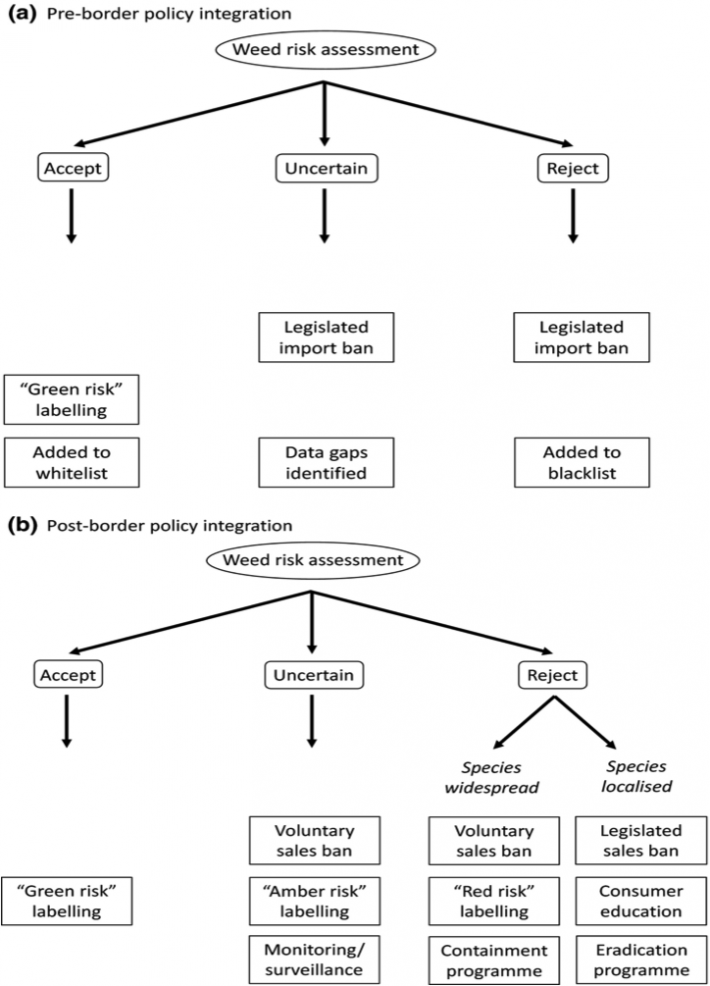New policies needed to stop invasive plants jumping the garden fence
Gardening brings pleasure to millions of citizens, has well-recognised health benefits and contributes significantly to the retail economy.

However, some of our most invasive alien plant species worldwide have jumped the garden fence to now threaten native biodiversity. For example, in the UK, problem plant species such as rhododendron, Himalayan balsam, Japanese knotweed and American skunk cabbage are all known to have escaped from gardens. Balancing the need for a productive garden industry against the threat of garden escapes impacting on native wildlife remains a major challenge.
Policy integration is key
An international team of scientists recently published a Policy Direction paper in Journal of Applied Ecology[i] which looks at ‘integrating invasive species policies across ornamental horticulture supply chains to prevent plant invasions’. The team believe that a healthier balance can be achieved with better integration of different policy tools.
“We examined the multitude of different approaches in managing garden escapes around the world and found that in most countries policies for managing alien plants were fragmented and uncoordinated”
explains Philip Hulme, Professor of Plant Biosecurity at the Bio-Protection Research Centre, Lincoln University and the lead author of the research. The authors found that in isolation, none of the existing policy instruments is sufficient to stem the problem however, by integrating policy instruments along the ornamental industry supply chain, the risks from invasive plant species is increasingly reduced. This schematic diagram, from the paper, represents how ‘different policy instruments can be integrated for different categories of plant species screened following plant risk assessment either (a) pre-border or (b) post-border’.

In order to manage the risk of invasive alien plants species from the national border to the garden bed, government, industry and the public need to have sufficient knowledge to make informed decisions regarding what to import, retail and purchase. This integrated approach aims to avoid creating the situation where species are illegally imported due to the procedures for importing a new plant species being perceived as too costly by the gardening industry.
Prevent the problem rather than reacting to the problem
While, the garden industry does often work with government and scientists to identify and remove known invasive plants from sale, previously it has often happened too late. As Professor Hulme points out
“collaborative working in managing garden escapes is essential but most sales bans only occur once the species has already jumped the garden fence and unless there is a concerted effort to eradicate such species, the problems are likely to persist even if the species is no longer available for purchase”.
Key recommendations to come out of the paper include a more rigorous approach to assessing risks from garden plants, supported by government and perhaps an industry levy that acts before species escape from gardens. This would be a substantial task given there are often many thousands of plant species, cultivars and varieties on sale in many countries. However, this does align with a strong principle of the EU Invasive Alien Species (IAS) Regulation that aims to prevent the invasive species causing environmental issues instead of reacting once the invasive species in causing a problem.
Pre-border interventions
The IAS Regulation aims to put in place “official controls on animals and plants …. to prevent the intentional introduction of invasive alien species” by avoiding intentionally or negligently bringing invasive alien species of EU concern into the EU. Hulme et al’s paper recommends effective pre-border interventions need to rely on rigorous risk assessment and high industry compliance. However, without mechanisms to check compliance, particularly in the face of increasing Internet trade in invasive plants, species will continue to escape from gardens and cause environmental issues in the wider environment.
Pre-border interventions are particularly important in the approach to tackling invasive alien plant species since, banning the sale of an invasive plant is going to be much less effective when the invasive species is already widespread within a region, be that within gardens or the wider countryside. Yet, this was the case in England when five aquatic plant species, Water Fern, Parrot’s Feather, Floating Pennywort, Australian Swamp Stone-crop (New Zealand Pygmyweed), and Water Primrose, were banned from sale in 2013.
Provide the public with the information to make an informed decision
In addition to pre-border restrictions on the import of invasive plant, Professor Hulme recommends that
“we should also be investing more in public awareness of this issue, perhaps by labelling species in relation to the risks they pose or giving much greater profile of native alternatives at the point of sale”.
The paper provides more detail and clear recommendations. It has been published the BES Journal of Applied Ecology and can be found http://onlinelibrary.wiley.com/doi/10.1111/1365-2664.12953/full
[i] Philip E. Hulme, et al (2017) Integrating invasive species policies across ornamental horticulture supply chains to prevent plant invasions. Journal of Applied Ecology doi: 10.1111/1365-2664.12953
Like what we stand for?
Support our mission and help develop the next generation of ecologists by donating to the British Ecological Society.